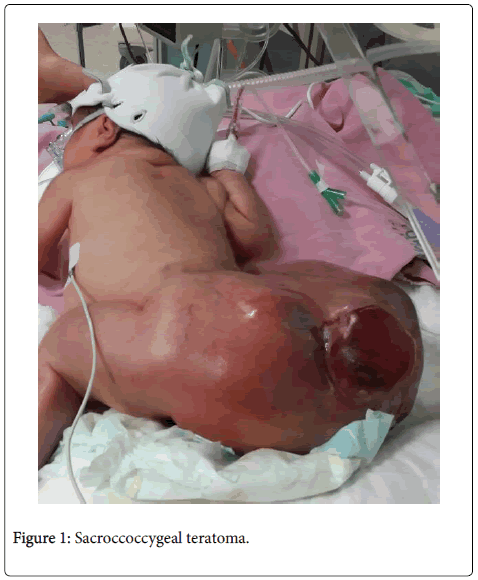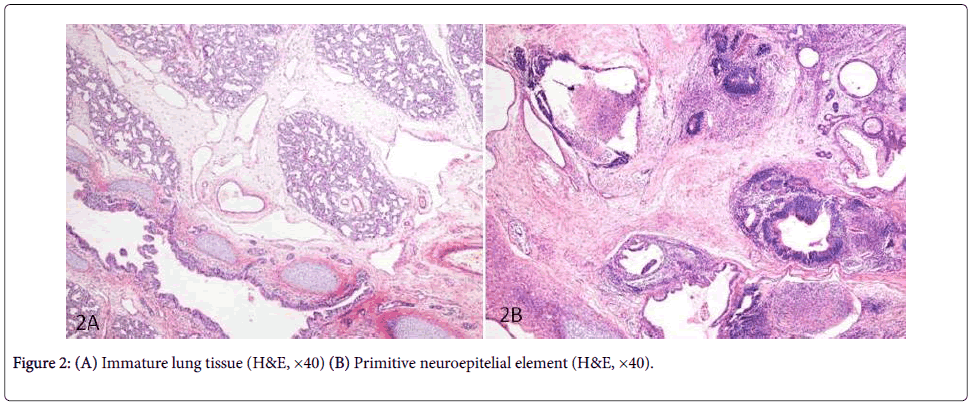Immature Teratoma Involving Lung Tissue in a Newborn
Received: 05-Oct-2017 / Accepted Date: 09-Nov-2017 / Published Date: 13-Nov-2017 DOI: 10.4172/2476-2024.1000128
Abstract
Sacrococcygeal teratoma, the most common fetal-neonatal neoplasia. While mature teratomas is having several well-differentiated mature tissues, immature teratomas consist of components that were not completely differentiated specific to the fetal tissue. Even though it might be seen that a several group of tissues such like bone, cartilage, skeleton muscle tissue, bowel and bronchiolar epithelium tissue inside the immature teratoma.
We reported a newborn with Sacrococcygeal mass which extended to gluteal region and at the right leg. In the histopathological study of the mass, immature cartilage and lung tissue were existed as well as grade III immature teratoma and immature neuroepithelial inside a tumor. We present a newborn case with big immature teratoma include lung tissue. Till now, lung tissue has not been reported in immature terotoma.
Keywords: Lung tissue; Newborn; Teratoma
Introduction
Sacrococcygeal teratoma (SCT), the most common fetal-neonatal neoplasia, occurs in frequency of 1/20,000. Mortality rate is in between 25-37%. It is related with the high morbidity and mortality rates that having of bigger, solid and vascular bulk [1].
That is classified as mature and immature according to differentiation of tumor cells histopathologically. Histologically, teratomas consist of bone, cartilage, skeleton muscle tissue, bowel epithelium tissue, bronchiolar epithelium tissue and neural tissue elements. While mature teratomas is having several well-differentiated mature tissues; immature teratomas consist of components that were not completely differentiated specific to the fetal tissue [2]. Even though it might be seen that a several group of tissues such like bone, cartilage, skeleton muscle tissue, bowel and bronchiolar epithelium tissue inside the immature teratoma, till now, lung tissue has not been reported. We wanted to report that a lung tissue inside a big immature teratoma in a newborn.
Case
A second alive baby which was born on time, 4630 g (measured weight with the mass) as a second pregnancy of a 28-year-old mother was resuscitated and supplied with oxygen in the delivery room. In the physical examination of the patient, the mass which is in dimension of 19 × 16 × 11 cm on the sacrococcygeal region and consist of cystic, vascular, necrotic and lobule structure was existed (Figure 1). The bulk was extended to gluteal region and at the right leg, it was limiting the movement. There was no feature on the other physical examination signs of the patient. The alpha fetoprotein was >54000 ng/ml, beta human chorionic gonadotropin level 93 mIU/ml was detected.
On the first postnatal day, mass excision was made from the patient. In the pathological study of the mass, macroscopically mass was in weight of 1180 g and consist of two parts. The bigger one, covered with skin, had 16.5 × 14 × 7 cmcm dimensions and rare cystic solid white parts on the cross section of it. The smaller one had random dirtywhite color, 10 × 5 × 4 cm dimensions and same properties. On the cystic tissue, local bleedings were observed. A coccyx was observed in dimension of 3 × 2 cm in the histopathological study of the mass, immature cartilage and lung tissue were existed as well as grade III immature teratoma and immature neuroepithelial inside a tumor (Figures 2A and 2B).
Discussion
Teratomas are the most common benign germ cells tumor at childhood and neonatal age that have endoderm, ectoderm and mesoderm tissues in different mutation levels. It is seen on the sacrococcygeal, mediastinal, retroperitoneal and gonads mostly; and rarely on head and neck. The sacrococcygeal teratomas has the frequency of 75% and has high morbidity and mortality rates because of perinatal complications such as preterm birth, anemia, hydrops, fetal dead, dystocia, spontaneous tumor hemorrhage or rupture. The tumor on the head and neck area as a high risk of asphyxia due to the airway obstruction risk [3].
Tumor size, growing speed, vascularity and clinically existence of polyhydroamniosis and placentomegaly with its solid component, cardiac decompensation and hydrops fetalis are all high risk factors for poor prognosis. Our patient did not have the clinically poor prognostic risk factors. On the histopathological study of the mass, local solid, necrotic and vascular parts have been detected. While prognosis of the mass, consisting cystic structure are much better, complicated cases frequently had mixed type and solid structure, and on these patients mortality might reach up to 50% [1,4].
Although sacrococcygeal tumors are related with pelvic organs, adhesion does not occur usually. However, it can apply pressure inside pelvis as covering the rectum. Tumors are generally tight adhesive to coccyx and it needs coccyx excision during surgical operation such like our case [5].
Together with that the most of the teratomas are mature, 20-25% of them are in immature properties. Tumor is graded according to ingredients of microscopic elements in the immature tissue. If the variability is less than 10%, grade 1; if between 10-50% it's grade 2 and if more than 50%, it’s graded as grade 3. Immature tissue generally consists of immature elements such like neuroepithelium, gland tissue, tubular tissue, retinal tissue, cartilage and primitive mesenchymal tissue. In conjunction with that, it has been reported rare cases which has nefroblastic elements [2,6].
Conclusion
To the best of our knowledge, a grade 3 immature teratom involving lung tissue with immature neuroepithelium and cartilage has not been reported yet. For this reason this case is presented to the attention of pediatric pathologists.
References
- Van Mieghem T, Al Ibrahim A, Deprest J, Lewi L, Langer JC, et al. (2014) Minimally invasive therapy for fetal sacrococcygeal teratoma: case series and systematic review of the literature. Ultrasound Obstet Gynecol 43: 611-619.
- Choudhury SR, Debnath PR, Pant N, Chowdhary L (2013) Congenital Immature Teratoma of the Retroperitoneum. J Neonatal Surg 2: 33.
- Arisoy R, Erdogdu E, Kumru P, Demirci O, Ergin N, et al. (2016) Prenatal diagnosis and outcomes of fetal teratomas. J Clin Ultrasound 44: 118-125.
- Hambraeus M, Arnbjörnsson E, Börjesson A, Salvesen K, Hagander L (2015) Sacrococcygeal teratoma: A population-based study of incidence and prenatal prognostic factors. J Pediatr Surg 51: 481-485
- Whalen TV, Mahour GH, Landing BH (1985) Sacrococcygeal teratomas in infants and children. Am J Surg 150: 373-375.
- Ma Y, Zheng J, Zhu H, Shen C, Zheng S, et al. (2014) Sacrococcygeal teratoma with nephroblastic elements: A case report and review of literature. Int J Clin Exp Pathol 11: 8211-8216
Citation: Turgut H, Gökce IK, Akatli A, Ozdemir R (2017) Immature Teratoma Involving Lung Tissue in a Newborn. Diagn Pathol Open 2: 128. DOI: 10.4172/2476-2024.1000128
Copyright: ©2017 Turgut H, et al. This is an open-access article distributed under the terms of the Creative Commons Attribution License, which permits unrestricted use, distribution, and reproduction in any medium, provided the original author and source are credited.
Share This Article
Open Access Journals
Article Tools
Article Usage
- Total views: 8069
- [From(publication date): 0-2017 - Nov 27, 2024]
- Breakdown by view type
- HTML page views: 7396
- PDF downloads: 673


